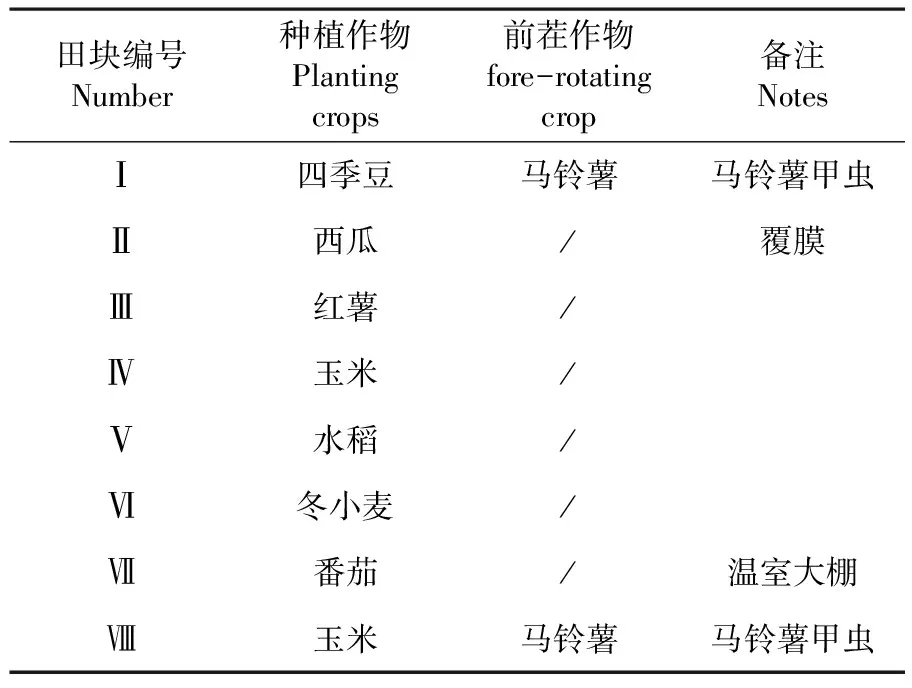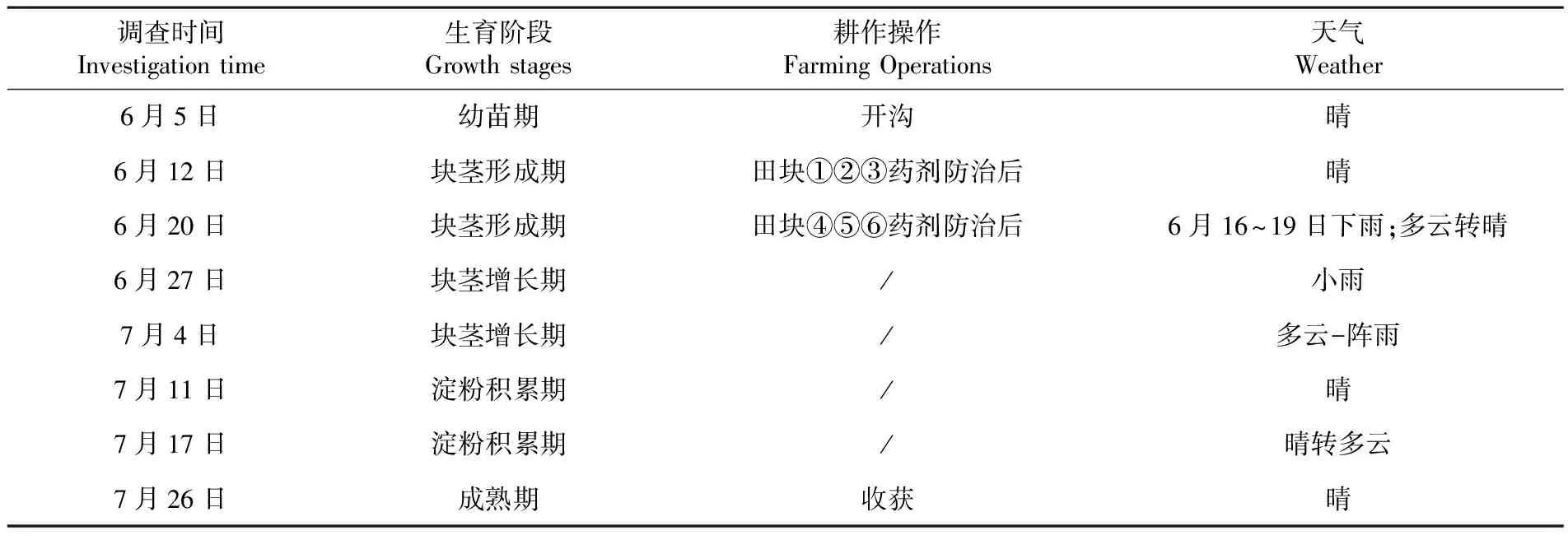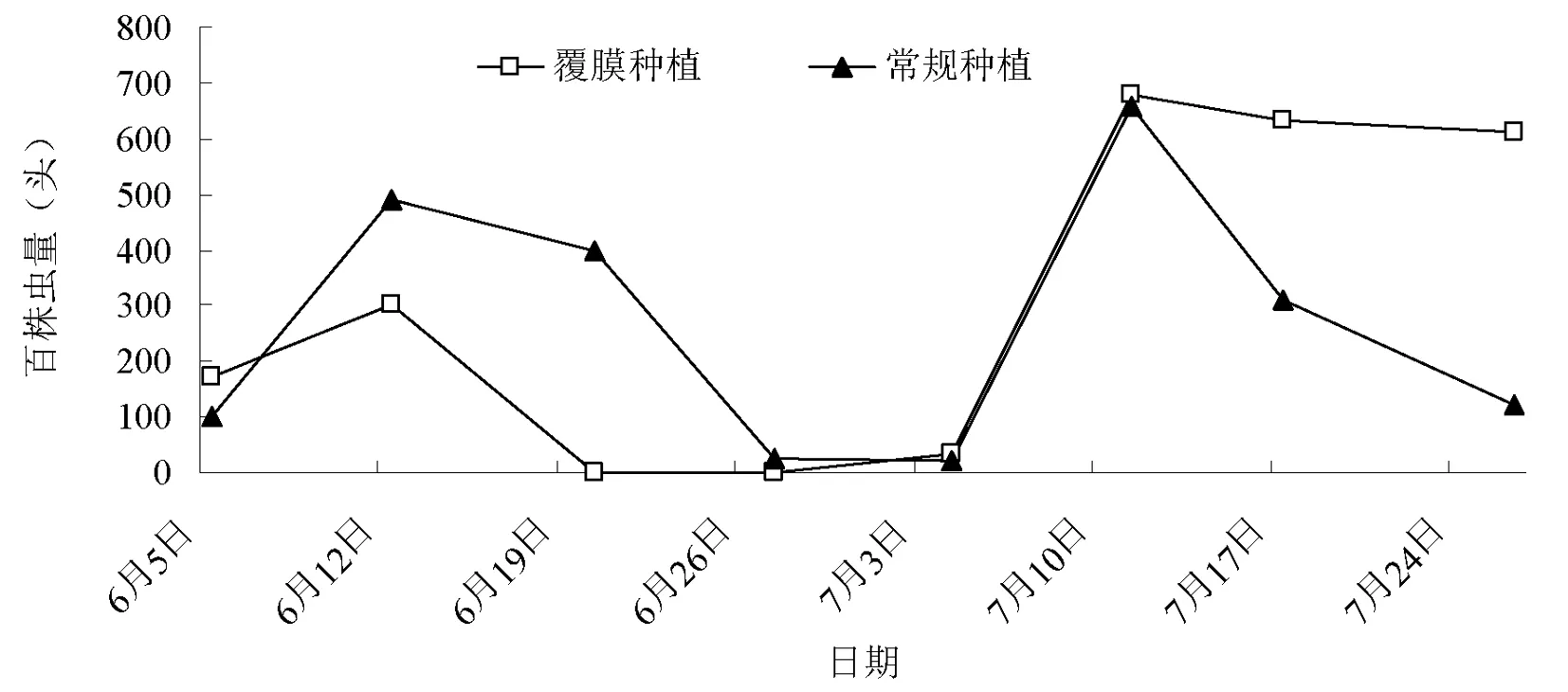邻近作物分布格局与地膜覆盖种植对马铃薯甲虫种群动态的影响
李超,丁新华,王小武,郭文超,吐尔逊·阿合买提,何江
(1. 新疆农业大学农学院/农林有害生物监测与安全防控重点实验室,乌鲁木齐 830052; 2. 新疆农业科学院植物保护研究所/农业部西北荒漠绿洲作物有害生物重点实验室,乌鲁木齐 830000; 3.石河子大学农学院,新疆石河子 832003;4.新疆农业科学院微生物应用研究所,乌鲁木齐 830091)
邻近作物分布格局与地膜覆盖种植对马铃薯甲虫种群动态的影响
李超1,丁新华2,王小武3,郭文超4,吐尔逊·阿合买提2,何江2
(1. 新疆农业大学农学院/农林有害生物监测与安全防控重点实验室,乌鲁木齐 830052; 2. 新疆农业科学院植物保护研究所/农业部西北荒漠绿洲作物有害生物重点实验室,乌鲁木齐 830000; 3.石河子大学农学院,新疆石河子 832003;4.新疆农业科学院微生物应用研究所,乌鲁木齐 830091)
【目的】明确邻近作物分布格局和地膜覆盖种植在马铃薯甲虫生态调控中的作用。【方法】对比现有种植模式中,研究邻近作物种类差异对马铃薯甲虫种群数量变化的影响。【结果】不同邻近作物种类马铃薯田块内马铃薯甲虫种群时空规律基本一致,但其种群数量存在显著差异,邻近上一年寄主田块的马铃薯田受危害严重,随距离的增加危害逐渐减轻。【结论】邻近种植不同作物对马铃薯田块内的马铃薯甲虫种群数量动态有一定的影响,可通过种植格局调整方式进行马铃薯甲虫种群生态控制。
马铃薯甲虫;邻近生境;种群动态;轮作;覆膜种植
0 引 言
【研究意义】马铃薯甲虫是世界公认的马铃薯毁灭性害虫,也是我国对外重大检疫对象,自20世纪90年代初侵入我国新疆北部地区以来,现已分布于新疆天山以北大部分地区,给当地马铃薯等茄科作物生产带来严重损失[1-3]。该虫具有很强的扩散能力,其持续扩散进入我国马铃薯主产区的风险依然巨大,对我国马铃薯产业构成严重威胁[4,5]。传统的化学防治在马铃薯甲虫防控中占主导地位,造成环境污染的同时也进一步加剧了马铃薯甲虫抗药性问题[6-8]。【前人研究进展】近年来,不少国内学者逐步重视生态调控技术[9]。张润志等[10]发明了苜蓿(Medicagosativa)-棉花(GossypiumhirsutumL.)的条带式种植,棉花-苜蓿条带式种植利用天敌在苜蓿和棉花上的空间转移控制了棉蚜;赵紫华等[11,12]通过多年的田间实验发现农业景观格局是影响害虫种群动态及群落组成的重要因素,农业景观规划与设计是害虫种群治理的可行途径。马铃薯甲虫是一种空间聚集型昆虫,种群聚集程度最高发生于寄主作物生长早期,并随着幼虫的逐步成熟而降低[13,14]。作物轮作是基于马铃薯甲虫与先前马铃薯田块的关系,发展形成的一种害虫管理策略[15]。早期的研究表明,马铃薯轮作距离超过400 m能有效减少当季马铃薯甲虫的定殖[16]。郭文超等[17]研究结果表明,不同距离轮作的种植方式能有效降低马铃薯甲虫种群密度,还可推迟越冬成虫迁入寄主田的时间,可普遍推迟发生期7 d 以上。覆膜栽培模式对于马铃薯甲虫具有明显的防治效果,虫口减退率达到50%~74%,马铃薯产量较未覆膜种植方式平均增产57.3%[18]。农田栖境管理是一种潜在可行的马铃薯甲虫种群生态控制策略,能有效减少化学农药使用[19,20]。【本研究切入点】新疆绿洲呈“岛屿”状分布,景观均质化高,规模化和小农户两种耕作体系并存,进行农田栖境管理具有得天独厚的优势条件。利用种植格局调整进行马铃薯甲虫种群防控尚未见相关报道。研究邻近作物分布格局和地膜覆盖种植在马铃薯甲虫生态调控中的作用。【拟解决的关键问题】对比现有种植模式中,邻近作物种类差异对马铃薯甲虫种群数量变化的影响,研究马铃薯甲虫的生态调控方法,为马铃薯甲虫种群综合防控提供理论基础。
1 材料与方法
1.1 材 料
试验地位于新疆察布查尔县良繁场(43°50′22.00″N, 81°12′16.19″E),该区域田块经常连片种植马铃薯,仅在小范围内倒茬。研究选择此区域内的6块马铃薯田块,依次编号①②③④⑤⑥,其中田块①②③④⑤位于防风林带北边,地块⑥位于防风林带南边,马铃薯田块呈南北向长条状分布,面积约10 hm2。田块③⑤属于早熟马铃薯品种,覆膜种植,播种时间早于其他马铃薯田块。
在马铃薯田块之间种植有其他作物,分别是田块Ⅰ地膜种植四季豆,前茬种植马铃薯,田块Ⅷ种植玉米,前茬种植马铃薯,前茬作物均有马铃薯甲虫发生,其中田块Ⅷ的马铃薯甲虫发生情况轻与田块Ⅰ。列出其他间隔作物种植情况。表1,图1
表1 马铃薯田块间隔作物种植情况
Table 1 Interval plant crops potato fields

田块编号Number种植作物Plantingcrops前茬作物fore-rotatingcrop备注NotesⅠ四季豆马铃薯马铃薯甲虫Ⅱ西瓜/覆膜Ⅲ红薯/Ⅳ玉米/Ⅴ水稻/Ⅵ冬小麦/Ⅶ番茄/温室大棚Ⅷ玉米马铃薯马铃薯甲虫

图1 试验区域作物种植格局
Fig.1 Crop planting pattern in experiment regions
1.2 方 法
马铃薯甲虫种群调查自6月5日开始,至7月底结束,每7 d调查一次。调查时,每块马铃薯田采用五点随机取样法,每点连续调查5株,记录每株马铃薯植株上马铃薯甲虫各不同虫态数量,包括卵块、一龄、二龄、三龄、四龄,成虫。表2
表2 马铃薯生长与耕作处理
Table 2 Potato growth stages and cultivation in field

调查时间Investigationtime生育阶段Growthstages耕作操作FarmingOperations天气Weather6月5日幼苗期开沟晴6月12日块茎形成期田块①②③药剂防治后晴6月20日块茎形成期田块④⑤⑥药剂防治后6月16~19日下雨;多云转晴6月27日块茎增长期/小雨7月4日块茎增长期/多云-阵雨7月11日淀粉积累期/晴7月17日淀粉积累期/晴转多云7月26日成熟期收获晴
1.3 数据统计
每块马铃薯田块调查得到的种群数量换算成百株虫量进行种群时空动态分析。比较不同田块马铃薯甲虫数量时直接用每点调查得到的虫量之和,即五株虫量进行差异分析。各田块之间相邻,马铃薯甲虫可进行种群迁移,种群数量之间并非完全独立,故不宜使用常规的基于独立样本的测验方法进行比较,研究将不同田块内马铃薯甲虫数量,运用非参数Kruskal-Wallis检验进行比较,所有数据采用SPSS16.0 软件进行处理。
2 结果与分析
2.1 马铃薯甲虫种群消长规律
不同马铃薯田块内的马铃薯甲虫种群消长规律基本一致,均发生两代,第一代幼虫高峰期在6月上中旬前后,此时进行了药剂防治,造成6月12~27日的三次调查中马铃薯甲虫种群数量基本为零(如田块1、2、3),或零星发生(如田块4、5、6),第二代高峰期在7月中旬(7月17日)出现,第二代高峰期马铃薯甲虫种群数量多高于第一代高峰期,如田块1~5,表明世代累积作用对种群数量增加的作用。单次调查的种群数量存在一定的差异。田块1和田块5的单次调查种群数量最大,在7月17日调查中,百株虫量最大分别达到1 068和1 080头;其他田块及其他时间调查的马铃薯甲虫百株虫量均低于800头。图2

图2 不同田块马铃薯甲虫种群消长规律
Fig.2 Population dynamics pattern of Colorado potato beetle in different potato fields.
2.2 不同田块间马铃薯甲虫种群数量比较
研究表明,从6月5日至7月26日的5次调查中,不同田块马铃薯甲虫种群密度各不相同。田块3和田块4马铃薯甲虫种群密度较大较小,田块1和田块6马铃薯甲虫种群密度较大。田间马铃薯甲虫虫量大小排列依次是:田块1>田块6>田块2>田块5>田块3>田块4,期中6月5日,各田块间差异显著(U=12.22,df=5,P<0.05);7月4日,各田块间差异极显著(U=21.56,df=5,P<0.01)。
7月11日,各田块间差异极显著(U=18.35,df=5,P<0.01);7月17日,各田块间,差异极显著(U=21.08,df=5,P<0.01);7月26日,各田块间,差异极显著(U=18.25,df=5,P<0.01)。图3

图3 不同田块间马铃薯甲虫种群数量比较
Fig.3 Population amount of Colorado potato beetle in different potato fields
2.3 覆膜种植模式对马铃薯甲虫种群数量的影响
田块3采用覆盖地膜的方法,种植早熟马铃薯品种,与其相邻连片的田块4种植常规马铃薯品种。通过对比分析两田块内的马铃薯甲虫种群数量动态可知,在调查前期(第一代马铃薯甲虫),覆膜种植的田块3马铃薯甲虫种群数量低于常规种植的田块4;调查后期(第二代马铃薯甲虫),覆膜种植的田块3马铃薯甲虫种群数量高于常规种植的田块4。图4

图4 覆膜种植与常规种植下马铃薯甲虫种群数量变化
Fig.4 Effect of film planting and conventional the population dynamic of Colorado potato beetle
3 讨 论
田间马铃薯甲虫种群丰富度受其与上一年马铃薯田块的距离的影响。研究中与田块1和田块6相邻的田块上一年种植作物为马铃薯,并有马铃薯甲虫发生,因此田块1和田块6马铃薯甲虫种群数量较大。越冬代马铃薯甲虫出土后最先定殖与邻近越冬点的田块1和田块6,随后继续向其它马铃薯田块迁移。研究结果与前人研究结果基本一致。临近上年越冬点的田块边缘最先被马铃薯甲虫定殖。大部分马铃薯甲虫成虫最初定殖于田块边缘20 m区域内,同时成虫会不断扩展其分布范围,随着其种群数量的增加,加强田块边缘20~40 m 区域内的马铃薯甲虫防控。
明确非寄主生境与寄主作物上马铃薯甲虫的扩散,对于马铃薯甲虫的种群管理措施同等重要[21]。临近马铃薯田块的景观结构包括裸露的荒地、公路、草地、池塘、河流和林地。马铃薯甲虫穿过上述农田生态系统主要依靠爬行和飞行[22-26]。由于田块6与其它马铃薯田块被防风林带分隔,越冬代马铃薯甲虫出土后越过防风林带进入其它马铃薯田块危害的可能性较小。前人研究结果曾指出田间马铃薯甲虫更趋向于沿行活动,而很少做跨行迁移。因此研究中田块4和田块5中早期的马铃薯甲虫虫源来自于哪里,是更靠近田块1的上一年寄主田还是靠近田块6的上一年寄主田块,需要进一步研究。混合植被的边界对马铃薯甲虫的爬行造成了临时阻隔[27,28]。研究在前人研究基础上,进一步明确了轮作在降低马铃薯甲虫越冬代成虫早期定殖种群密度中的作用,并结合邻近种植作物的种类差异,初步分析了邻近作物种植格局对马铃薯甲虫种群密度的影响,为进一步研究马铃薯甲虫生境调控打下基础。
景观连通性和边界阻隔等因素对马铃薯甲虫的扩散产生一定的影响,景观连通性管理是防控马铃薯甲虫再定殖和季节性入侵的关键元素[29]。相比较生境而言,边界阻隔等物理因素对于决定马铃薯甲虫的扩散模式具有更强的作用。田块附近的自然生境等综合信息也会影响田间马铃薯甲虫种群丰富度。诱集植物、物理阻隔、边界药剂处理或空白处理,在有害生物综合治理中扮演重要作用。覆膜种植的田块3在调查前期,马铃薯甲虫种群数量低于常规种植的田块4可能是由于覆膜影响了马铃薯甲虫老熟幼虫的入土羽化和羽化成虫的出土;而调查后期,覆膜种植的田块3马铃薯甲虫种群数量高于常规种植的田块4的原因尚不明确。通常情况下覆膜种植在一定程度上制约了田间杂草的生长,寄主植物长势会好于非覆膜种植,同时覆膜种植多为早熟品种,后期寄主植株长势衰落早于常规品种。前人研究报道生境中植物相对质量和生长状况能改变马铃薯甲虫扩散比率,长势衰落的寄主植物,相比较常规马铃薯更容易让马铃薯甲虫夏季种群迁飞[30,31]。
4 结 论
调查不同邻近作物的马铃薯田块内马铃薯甲虫种群动态规律,距离上一年寄主田块的远近对翌年越冬代马铃薯甲虫的早期定殖具有一定的影响,具体表现为,距离上一年寄主田块近的田块更容易被早期定殖,且受危害程度较重;覆膜种植模式对马铃薯甲虫的发生会带来一定的影响,表现为地膜制约老熟幼虫的入土羽化和羽化后出土。邻近种植不同作物对马铃薯田块内的马铃薯甲虫种群数量动态有一定的影响,可通过种植格局的调整的方式进行马铃薯甲虫种群生态控制。
References)
[1] 吐尔逊·阿合买提,许建军,郭文超,等. 马铃薯甲虫主要生物学特性及发生规律研究[J]. 新疆农业科学, 2010,47(6):1 147-1 151.
Tuerxun Ahemaiti, XU Jian-jun, GUO Wen-chao, et al. (2010). Study on major biological characteristics and occurrence regulation of Colorado potato beetle [J].XinjiangAgriculturalSciences, 47(6):1,147-1,151. (in Chinese)
[2]郭文超,吐尔逊,许建军,等. 马铃薯甲虫识别及其在新疆的分布、传播和危害[J]. 新疆农业科学, 2010,47(5):906-909.
GUO Wen-chao, TuerxunoAhemaiti, XU Jian-jun, et al. (2010). Research on the identification of Colorado potato beetle& Its distribution dispersal and damage in Xinjiang [J].XinjiangAgriculturalSciences, 47(5):906-909. (in Chinese)
[3]郭文超,吐尔逊,程登发,等. 我国马铃薯甲虫主要生物学, 生态学技术研究进展及监测与防控对策[J]. 植物保护, 2014,40(1):1-11.
GUO Wen-chao, Tuerxun Ahemaiti, CHENG Deng-fa, et al. (2014). Main progress on biology & ecology of Colorado potato beetle and countermeasures of its monitoring and controlling in China [J].PlantProtection, 40(1):1-11. (in Chinese)
[4] Ning Liu , Yingchao Li , & Zhang, R. (2012). Invasion of colorado potato beetle, leptinotarsa decemlineata, in china: dispersal, occurrence, and economic impact.EntomologiaExperimentalisEtApplicata, 143(143):207-217.
[5]Alyokhin, A., & Alyokhin, A. (2009). Colorado potato beetle management on potatoes: current challenges and future prospects.Fruit,Veg.CerealSci.Biotech, (3):10-19.
[6]Alyokhin, A., Baker, M., Mota-Sanchez, D., Dively, G., & Grafius, E. (2009). Colorado potato beetle resistance to insecticides.AmericanJournalofPotatoResearch, 85(6):395-413.
[7]Jiang, W. H., Wang, Z. T., Xiong, M. H., Lu, W. P., Liu, P., & Guo, W. C., et al. (2010). Insecticide resistance status of colorado potato beetle (coleoptera: chrysomelidae) adults in northern xinjiang uygur autonomous region.JournalofEconomicEntomology, 103(4):1,365-1,371.
[8]Jiang, W. H., Xiong, M. H., Wang, Z. T., Wei-Ping, L. U., Liu, P., & Guo, W. C., et al. (2010). Incidence and synergism of resistance to conventional insecticides in larvae of the colorado potato beetle,leptinotarsa decemlineata (say)(coleoptera:chrysomelidae), in northern xinjiang,china.ActaEntomologicaSinica, 53(12):1,352-1,359.
[9] 陈学新, 刘树生, 任顺祥, 等. 害虫天敌的植物支持系统[J]. 应用昆虫学报, 2014, 51(1):1-12.
CHEN Xue-xin, LIU Shu-sheng, REN Shun-xiang, et al. (2014). Plant-mediated support system for natural enemies of insect pests [J].ChineseJournalofAppliedEntomology, 51(1):1-12. (in Chinese)
[10] 张润志, 梁宏斌, 田长彦, 等. 利用棉田边缘苜蓿带控制棉蚜的生物学机理[J]. 科学通报, 1999,44(20):2 175-2 178.
ZHANG Run-zhi, LIANG Hong-bin, TIAN Chang-yan, et al. (1999). The biological mechanism of control cotton aphids by planting alfafla surrounding cotton field [J].ChineseScienceBulletin, 44(20):2,175-2,178. (in Chinese)
[11] 赵紫华, 王颖, 贺达汉, 等. 麦蚜和寄生蜂对农业景观格局的响应及其关键景观因子分析[J]. 生态学报, 2012,32(2):472-482.
ZHAO Zhi-hua, WANG Yi, HE Da-hai, et al. (2012). Effects of landscape structure and key landscape factors on aphids-parasitoids-hyperparasitoids populations in wheat fields [J].ActaEcolSin, 32(2):472-482. (in Chinese)
[12] 赵紫华, 欧阳芳, 贺达汉. 农业景观中不同生境界面麦蚜天敌的边缘效应与溢出效应[J]. 中国科学: 生命科学, 2012,42(10):825-840.
ZHAO Zhi-hua, OU Yang-fang, HE Da-han. (2012). Edge effects and spillover effects of natural enemies on different habitat interfaces of agricultural landscape.ScienceinChina:LifeSciences, 42(10):825-840. (in Chinese)
[13] Blom, P. E., & Fleischer, S. J. (2001). Dynamics in the spatial structure of leptinotarsa decemlineata (coleoptera: chrysomelidae).EnvironmentalEntomology, 30(2):350-364.
[14] Blom, P. E., & Fleischer, S. Z. (2002). Spatial and temporal dynamics of colorado potato beetle (coleoptera : chrysomelidae) in fields with perimeter and spatially targeted insecticides.EnvironmentalEntomology, 31(1):149-159.
[15]Alyokhin, A., Mota-Sanchez, D., Baker, M., Snyder, W. E., Menasha, S., & Whalon, M., et al. (2015). The red queen in a potato field: integrated pest management versus chemical dependency in colorado potato beetle control.PestManagementScience, 71(3):343-356.
[16] Sexson, D. L., & Wyman, J. A. (2015). Effect of crop rotation distance on populations of colorado potato beetle (coleoptera: chrysomelidae): development of areawide colorado potato beetle pest management strategies.JournalofEconomicEntomology, 98(3):716-724.
[17]郭文超,吐尔逊,许咏梅,等. (2011). 马铃薯甲虫持续防控技术研究与应用. 新疆农业科学, 48(2):197-203.
GUO Wen-chao, Tuerxun Ahemaiti, XU Yong-mei, et al. (2011). Study and application on sustained and integrated control techniques of Colorado potato beetle [J].XinjiangAgriculturalSciences, 48(2):197-203. (in Chinese)
[18]许咏梅,郭文超,谢香文,等. (2011). 新疆马铃薯甲虫对不同施肥及品种的响应[J]. 西北农业学报, 20(4):179-185.
XU Yong-mei, GUO Wen-chao, XIE Xiang-wen, et al. (2011). Response of Colorado potato beetle quantity in Xinjiang under different variety and fertilizer [J].ActaAgriculturaeBoreali-occidentalisSinica, 20(4):179-185. (in Chinese)
[19]Weber, D. C., & Ferro, D. N. (1994). Movement of overwintered colorado potato beetles in the field.JournalofAgriculturalEntomology. (11):17-27.
[20]Schmera, D., &. Szentesi, & Jermy, T. (2007). Within field movement of overwintered colorado potato beetle: a patch-based approach.JournalofAppliedEntomology, 131(131):34-39.
[21]Weber D,Ferro D. (1994). Colorado potato beetle: diverse life history poses challenge to management. Advances in Potato Pest Biology and Management. APS Press, St. Paul: 54-70.
[22]Boiteau, G., Alyokhin, A., & Ferro, D. N. (2003). The colorado potato beetle in movement.CanadianEntomologist, 135(135):1-22.
[23] Boiteau, G. (2009). Within-field spatial structure of colorado potato beetle (coleoptera: chrysomelidae) populations in new brunswick.EnvironmentalEntomology, 34(Apr 2005):446-456.
[24]Boiteau, G. (2001). Recruitment by flight and walking in a one-generation colorado potato beetle (coleoptera: chrysomelidae) environment.EnvironmentalEntomology, 30(2):306-317.
[25]Boiteau, G. (2002). Flight takeoff behavior of colorado potato beetle.CanadianEntomologist, 134(2):229-240.
[26]Alyokhin, A., & Miller, L. (2015). Propensity for flying and walking by the colorado potato beetles treated with imidacloprid.AmericanJournalofPotatoResearch, 92(1):138-142.
[27]Boiteau, G., Vincent, C., Leskey, T. C., Colpitts, B. G., Mackinley, P., & Lee, D. H. (2013). Impact of host plant connectivity, crop border and patch size on adult colorado potato beetle retention.PlosOne, 9(5):e95717.
[28]Boiteau, G., & Mackinley, P. (2015). Contribution of habitat type to residency and dispersal choices by overwintered and summer adult colorado potato beetles.EntomologiaExperimentalisEtApplicata, 155(3):249-256.
[29]Mackinley, G. B. P. (2013). Dispersal of adult colorado potato beetles (coleoptera: chrysomelidae) on plant models.CanadianEntomologist, 145(145):20-28.
[30] Boiteau, G., Picka, J. D., & Watmough, J. (2013). Potato field colonization by low-density populations of colorado potato beetle as a function of crop rotation distance.JournalofEconomicEntomology, 101(5):1,575-1,583.
Fund project:Supported by Guangdong Province science and technology plan (2014A020209067) and NSFC(31660545)
Effect of Neighboring Crops Distribution Patterns and Film Mulching on the Population Dynamics of Colorado Potato Beetle,Leptinotarsadecemlineatain Xinjiang
LI Chao1, DING Xin-hua2, WANG Xiao-wu3, GUO Wen-chao4, Tuerxun Ahemaiti2, HE Jiang2
(1.CollegeofAgronomy/KeyLaboratoryoftheAgricultureandForestryPestMonitoringandSafetyControlatUniversitiesofXinjiangUygurAutonomousRegion,XinjiangAgriculturalUniversity,Urumqi830052,China; 2.KeyLaboratoryofIntegratedManagementofHarmfulCropVermininChinaNorth-westernOasis,MinistryofAgriculture,P.R.China/ResearchInstituteofPlantProtection,XinjiangAcademyofAgriculturalSciences,Urumqi830091,China; 3.CollegeofAgronomy,Shihezivniversity,ShiheziXinjiang, 832003,China; 4.ResearchInstituteofAppliedMicrobiology,XinjiangAcademyofAgricualturalscience,Urumqi830091,China)
【Objective】 The study focuses on clarifying the role of neighboring crops distribution patterns and plastic film mulching cultivation in ecological regulation of Colorado potato beetle.【Method】The present study compared the differences of Colorado potato beetle population in potato fields accompanied by different adjacent crops in existing cropping patterns.【Result】There were basically the same population dynamic patterns among different potato fields with other different kinds of adjacent crops, but there were significant differences among their population amount of Colorado potato beetle. Near the previous year's potato fields, the fields were damaged seriously, but the damage levels would be reduced with increasing distance between the potato fields.【Conclusion】Planting different kinds of crops influences the population dynamic of Colorado potato beetle to a certain extent and the ecological control of the Colorado potato beetle population can be carried out by adjusting the planting pattern.
Leptinotarsadecemlineata; neighboring habitat; population dynamics; crop rotation; Plastic film mulching cultivation
2016-09-30
广东省科技计划“新疆景观特征对马铃薯甲虫扩散的影响及其对策研究”(2014A020209067); 国家自然科学基金“荒漠绿洲生境对马铃薯甲虫种群扩散的影响机制”(31660545); 新疆农业大学博士后流动站资助
李超(1985-),男,讲师,研究方向为外来有害生物监测预警技术,(E-mail) lichaoyw@163. com
郭文超(1966-),男,河北人,研究员,博士生导师,研究方向为外来入侵生物综合治理,( E-mail)gwc1966@163.com
10.6048/j.issn.1001-4330.2017.01.015
S435.32
A
1001-4330(2017)01-0117-07

